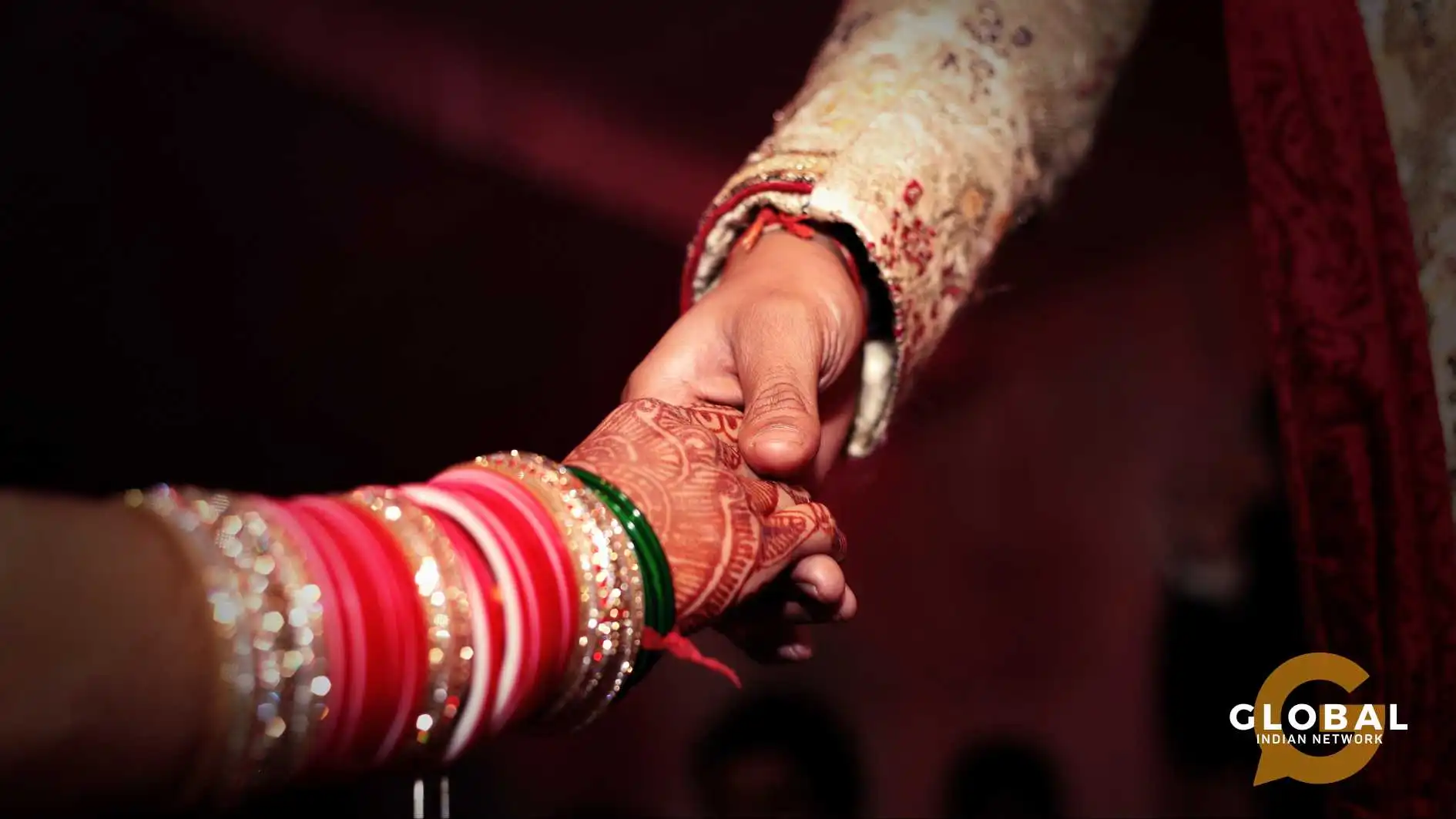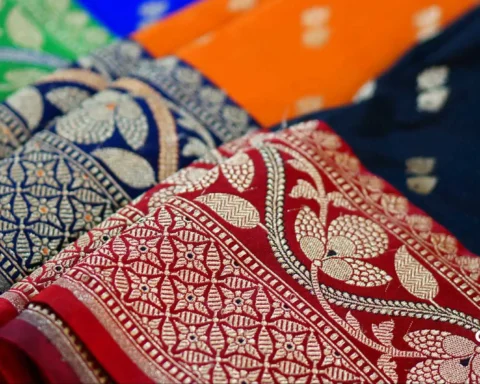Where Tradition Meets Trillion-dollar Ambition
When love becomes an industry, the business of the Indian wedding reveals a dazzling $50 billion marketplace that thrives even when the world economy falters.
In May 2025, the Economic Times described India’s wedding industry as “notably recession-proof,” and with good reason. Even during economic slowdowns, the sector demonstrates remarkable resilience, anchored by the country’s demographic strength and deep-rooted cultural traditions.
With 11–12 million weddings taking place every year, Indian families consistently prioritize celebration, lavish hospitality, and high-value purchases, regardless of broader financial challenges. This unyielding demand supports a thriving ecosystem: luxury services, designers, venues, and global destination events continue to flourish. As experts observe, the industry’s sustained growth and stability make it a compelling arena for entrepreneurs and investors seeking commercially viable opportunities.
In the interests of our esteemed readers and beyond, we have done the research. The potential is immense for all global Indians.
Read on.
Table of Contents
The Big Fat Global Indian Wedding: A $50 Billion Opportunity
When the dhol beats echo across Dubai dunes, French châteaux glimmer with marigolds, and Caribbean beaches host sacred pheras under designer mandaps, it becomes clear that the Indian wedding has gone global. What was once a traditional family affair has evolved into a $50 billion economic ecosystem stretching across continents, fusing culture, commerce, and cosmopolitan identity. The modern “Big Fat Indian Wedding” is no longer bound by geography; it’s a spectacle of global scale and sophistication, driven by the global Indians’ wealth and a booming event economy.
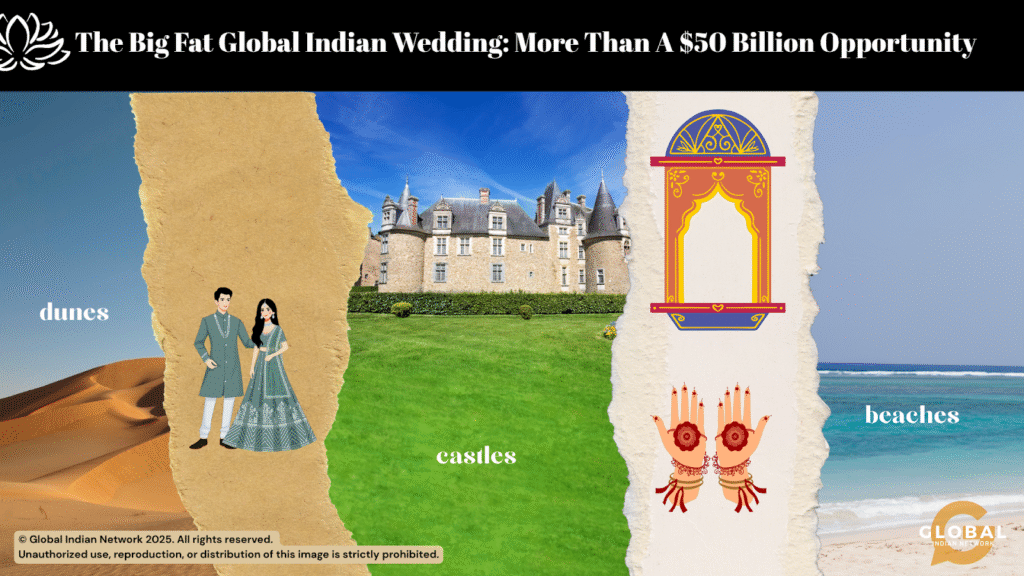
A Global Phenomenon Anchored in Tradition
Weddings have always held monumental significance in Indian society, both as spiritual unions and social milestones. But today’s Indian weddings, whether hosted in Jaipur palaces or Lake Como villas, signify more than ritual grandeur; they exemplify aspiration, mobility, and globalization.
| “The Global Indian wedding is more than an event – it’s a billion-dollar bridge between cultures. Each mandap abroad tells a story of modern identity rooted in ancient celebration.” – Global Indian Network |
An average wedding for affluent Indians, whether domestic or overseas, can range anywhere from ₹1 crore to ₹10 crore (approximately $117,600 USD to $1,176,500 USD), with ultra-luxury events exceeding ₹100 crore (roughly $11.38 million USD). Among the global Indians, these budgets rise exponentially. Families in the U.S., the UK, the Middle East, and Africa spend millions blending Indian traditions with global sensibilities, creating hybrid celebrations that showcase both heritage and modern luxury.
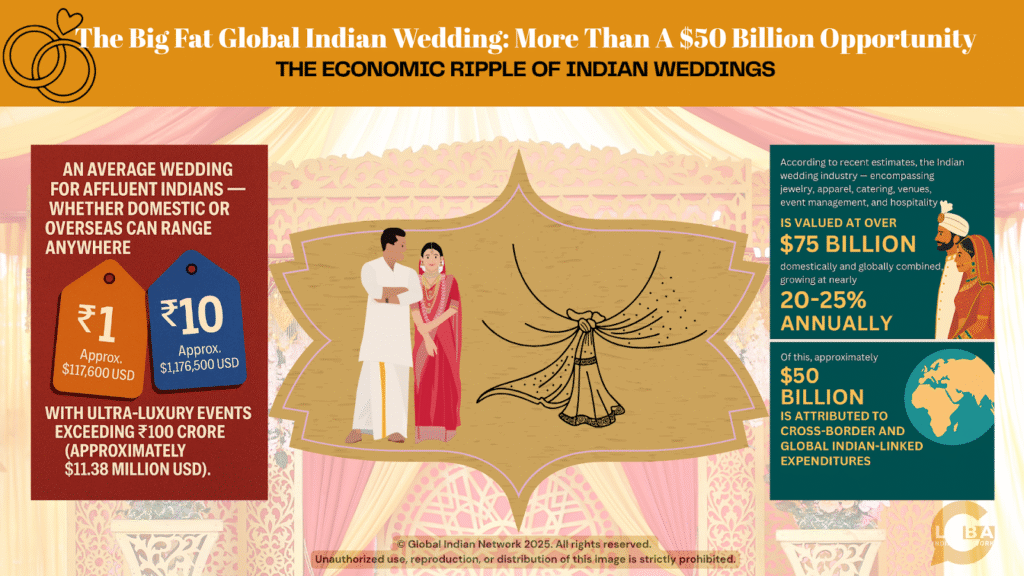
From designer lehengas that travel from Delhi to Dublin to vegan halwai chefs flown to Hawaii, every detail reflects a transnational narrative. It’s an economy of emotion and expression, where culture meets capital.

Numbers That Dazzle: The $50 Billion Industry
According to recent estimates, the Indian wedding industry, encompassing jewelry, apparel, catering, venues, event management, and hospitality, is valued at over $75 billion domestically and globally combined, growing at nearly 20–25% annually. Of this, approximately $50 billion is attributed to cross-border and global Indian-linked expenditures.
Key Contributors to This Figure Include
- Destination weddings: From Thailand and Bali to Vienna and Cape Town, destination weddings account for nearly 14–16% of total spending, according to the WeddingWire India Insights Report 2025.
- Luxury hospitality: Hotels and resorts in the UAE, Italy, and Malaysia compete fiercely to attract Indian weddings, offering heritage-themed packages with curated rituals and cuisine.
- Jewelry and apparel: Bridal fashion houses like Sabyasachi, Manish Malhotra, and Tarun Tahiliani have become global brands, commanding massive global Indian demand. The segment contributes over $20 billion annually.
- Digital services: Wedding content creation, streaming, AI-generated invites, and virtual event coordination form a growing tech sub-sector, valued at around $5 billion.
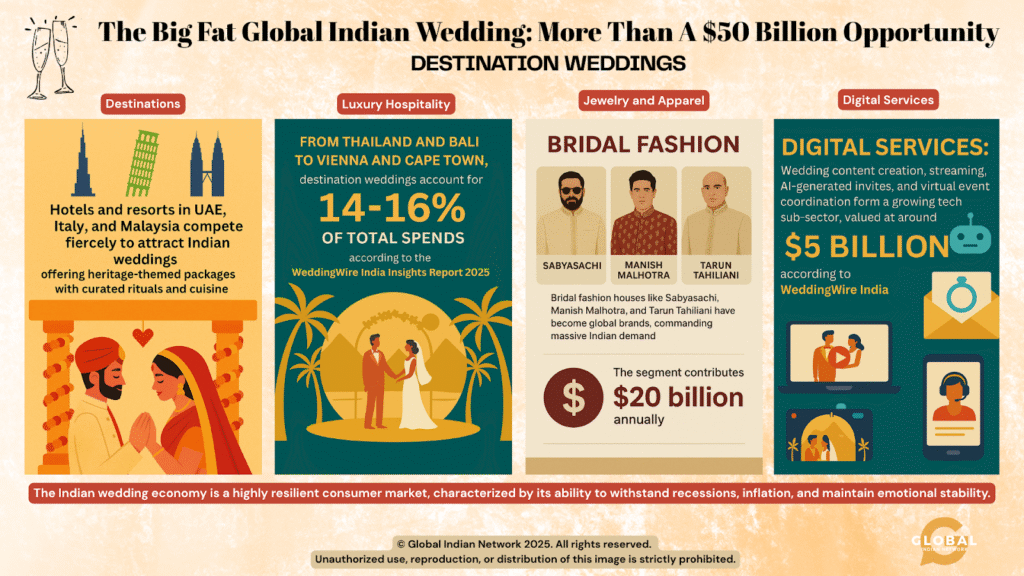
This scale positions the Indian wedding economy as one of the most resilient consumer markets, recession-proof, inflation-resistant, and emotionally indispensable.
Research at the Global Indian Network has found the following:
| A breakdown of wedding expenditure in India (CY 2023) shows categories like catering & venues (29.4%), jewellery (22.3%), apparel (4.3%), etc. A survey of modern wedding trends shows 36% of Gen X couples used LED screens, 29% used e-invites, 28% used drone photography, indicating increasing tech adoption. Growth estimates for broader wedding services and planning markets exist (e.g., the Indian wedding services market is expected to reach US$228.69 billion by 2030). |
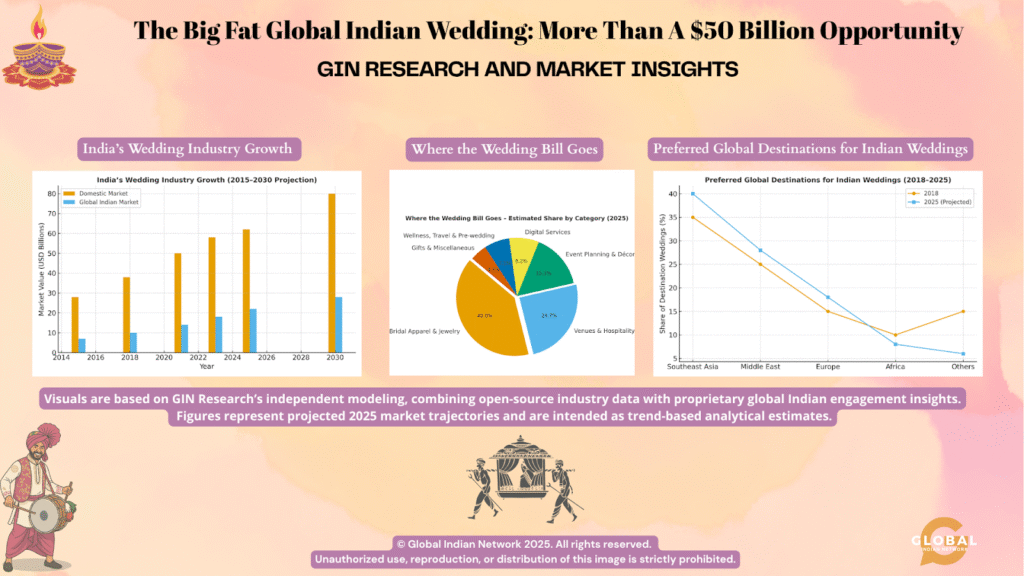
Global Indians Dynamics and Cross-Border Commerce
The global Indian community, exceeding 35 million, has redefined how and where weddings are celebrated. In London, Nairobi, Toronto, or New Jersey, multi-day ceremonies merge Indian aesthetics with local flavors, a Punjabi baraat parading to Afrobeats or a Tamil ceremony beside a Californian vineyard.
| “Even as global markets fluctuate, India’s wedding economy never stops celebrating.” — Economic Times & CNBC TV-18 Reports (2025) |
In destination countries, these global Indian weddings are major drivers of tourism. Thailand earns nearly $500 million annually from Indian weddings, while the UAE, particularly Ras Al-Khaimah and Dubai, actively markets itself as a multicultural wedding hub.
Global Indian entrepreneurs have also built robust ecosystems abroad, from MandapWorld in Canada to boutique planners in Mauritius and Fiji, facilitating seamless cultural experiences. These firms bridge logistical gaps: importing priests, managing customs documentation for gold jewelry, or ensuring religious food compliance in foreign kitchens.
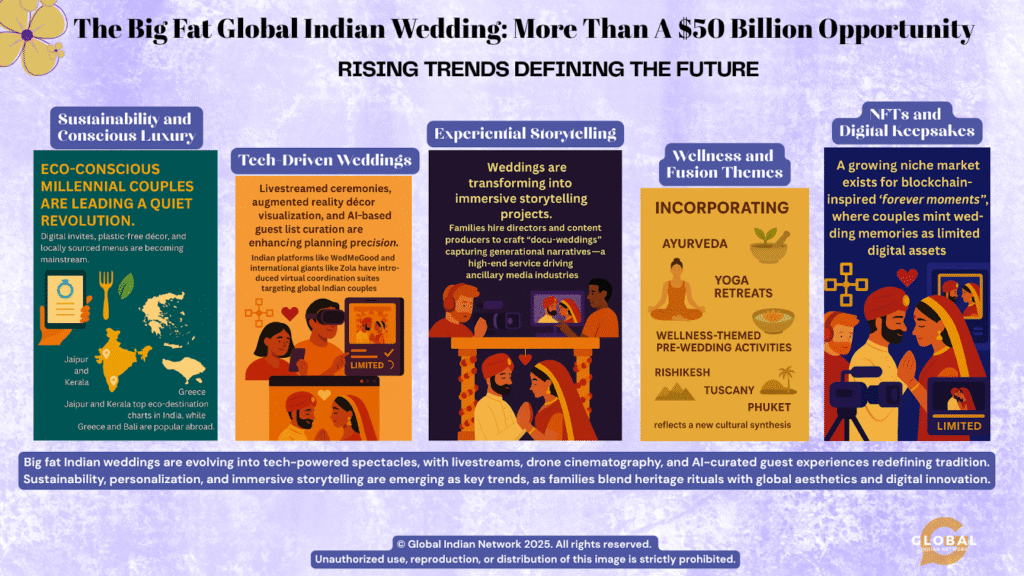
Rising Trends Defining the Future
- Sustainability and Conscious Luxury: Eco-conscious millennial couples are leading a quiet revolution. Digital invites, plastic-free décor, and locally sourced menus are becoming mainstream. Jaipur and Kerala top the charts for eco-destinations in India, while Greece and Bali are popular abroad.
- Tech-Driven Weddings: Livestreamed ceremonies, augmented reality décor visualization, and AI-based guest list curation are enhancing planning precision. Indian platforms like WedMeGood and international giants like Zola have introduced virtual coordination suites for global Indian couples.
- Experiential Storytelling: Weddings are transforming into immersive storytelling projects. Families hire directors and content producers to craft “docu-weddings” that capture generational narratives, a high-end service driving ancillary media industries.
- Wellness and Fusion Themes: Incorporating Ayurveda, yoga retreats, and wellness-themed pre-wedding activities in places like Rishikesh, Tuscany, or Phuket reflects a new cultural synthesis.
- NFTs and Digital Keepsakes: A growing niche market exists for blockchain-inspired “forever moments,” in which couples mint wedding memories as limited-edition digital assets.
India’s Wedding Capitalism: Domestic Multiplier Effect
Domestically, the wedding season fuels 3% of India’s GDP. During peak months, over 3 million weddings can occur nationwide. This consumer wave revitalizes small-scale sectors, from bandwalas and florists to caterers and photographers.
Platforms like Printo, WedBook, and UrbanClap connect thousands of micro-entrepreneurs catering to rising middle-class demand. For global investors and startups, India’s wedding-tech space resembles the early 2010s e-commerce boom: fragmented but ripe for consolidation.
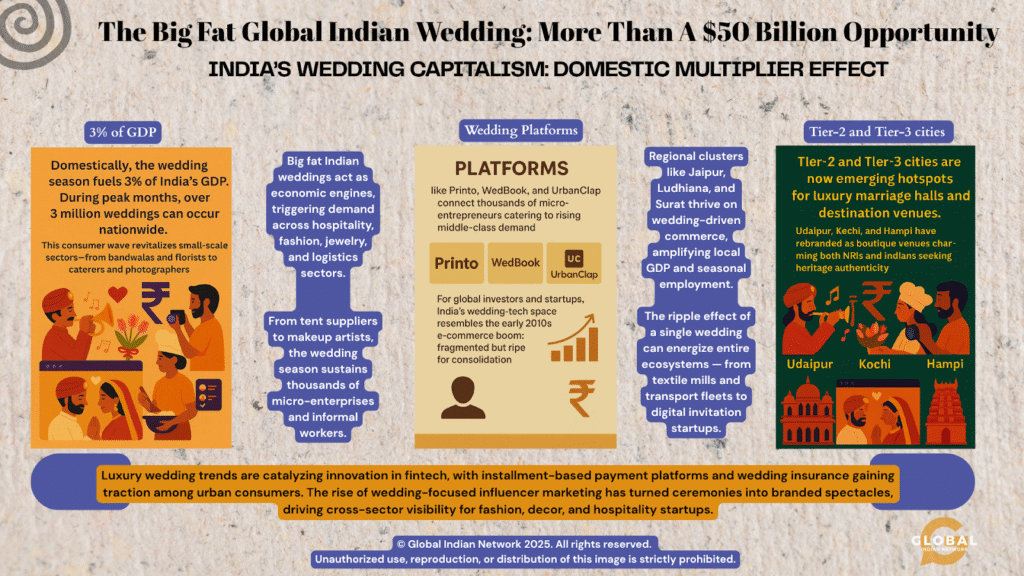
Tier-2 and Tier-3 cities are now emerging hotspots for luxury marriage halls and destination venues. Udaipur, Kochi, and Hampi have rebranded as boutique venues, charming both NRIs and Indians seeking heritage authenticity.
Powering Global Indian Identity and Soft Diplomacy
Perhaps most fascinating is how the global Indian wedding acts as cultural diplomacy. Each international wedding becomes a soft-power showcase of India’s art, food, textiles, and rituals. When Lake Como witnessed Priyanka Chopra and Nick Jonas’s cross-cultural nuptials, or when the UAE’s royal venues hosted Marwari weddings, India’s traditions gained cinematic global exposure.
Nations now court the Indian wedding market as a strategic tourism investment. Mauritius, Seychelles, and Oman have launched dedicated liaison offices in Mumbai and Dubai to attract Indian families. Indian designers, meanwhile, are staging bridal pop-ups in London and Singapore to reach global Indian clients months before event bookings.
The Road Ahead: A Sustainable $100 Billion Vision
As global Indian wealth and intercontinental connectivity rise, analysts foresee the industry increasing to more than $100 billion by 2030. The growth trajectory aligns with the expanding global Indian population, higher disposable incomes, and the glamourization of multicultural unions.

As digitization, sustainability, and inclusivity reshape the contours of celebration, the big fat global Indian wedding emerges not merely as a festive milestone but as a living tapestry where India’s heritage dances with modernity across the world stage. Documented and amplified by platforms like the Global Indian Network, these weddings reflect a deeper narrative: one of cultural continuity, global identity, and the evolving language of love in a connected world.

Conclusion
As global Indian wealth and intercontinental connections expand, the wedding economy stands at a defining crossroads, where culture meets capital and celebration fuels enterprise.
The next decade will see the industry evolve beyond opulence into a more conscious, tech-driven ecosystem, reflecting the values of a generation that blends sustainability with status, and innovation with identity.
Yet beneath the numbers lies something timeless: the Indian instinct to celebrate, to bring people together, and to find joy in continuity. Each wedding, whether in Jaipur, Lake Como, or Dubai, becomes both a personal milestone and a soft-power statement, showcasing India’s creative strength to the world.
At the Global Indian Network, we see this not just as an economic opportunity but as a cultural movement, a story of how heritage, entrepreneurship, and global ambition converge in the most joyful expression of all: the Indian wedding.
Through our stories, visuals, and community conversations across 49 countries, we continue to chronicle how global Indians are shaping industries, redefining identity, and keeping India’s celebratory spirit alive on the world stage.
Join the conversation.
Explore more insights, share your story, or collaborate with our growing global community at globalindiannetwork.com, where every idea, celebration, and innovation adds to the evolving story of the Global Indian.




